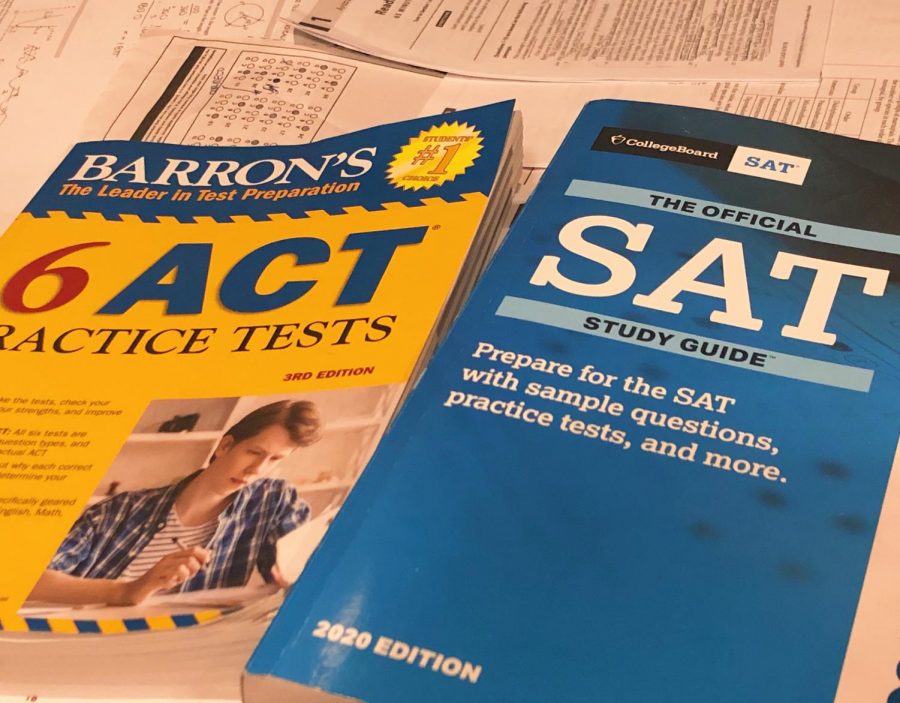To test or not to test: The senior college application dilemma
Many seniors spent countless hours preparing for standardized testing… was it worth it?
What is 120% of 200? How would an advocate for the study most likely defend the results of the data? Which of the following choices provide the best evidence for the answer to the previous question?
For many upperclassmen, learning how to solve these problems is an essential practice, one that for decades has shaped the college admissions process. Even in the midst of a pandemic and civil unrest, completing the SAT remains a graduation prerequisite for high school seniors in District 99. However, in light of nationwide testing availability shortages due to COVID-19 safety concerns, many universities have dropped their testing requirements for the class of 2021.
With this considered, seniors now have an additional question on their minds: is it even worth it to endure the trouble of studying for and submitting a standardized test?
Most universities vow to practice “holistic admissions” when reviewing applicant profiles, which means admission officers will assess every part of each applicant’s profile, not just their test score, to decide whether or not they’ll gain acceptance to their institution. This admissions cycle, the general consensus most colleges agree upon is prospective students who choose not to submit a test score will not be penalized because the other aspects of their applications will paint an accurate picture of their intellectual capacity and extracurricular involvement. If students do choose to submit a test, colleges have made it clear that the score will be only “one of the many factors” used to evaluate them.
This sounds like a fair compromise, right? Not exactly.
For one, when applicants do not submit a test score, the next most prominent quantifiable number on their application is their GPA. The issue here is that while standardized testing is, well, standardized among every test taker, GPA calculation methods vary between institutions. Some schools use a weighted system, others stick to unweighted methods; some schools count both honors and AP/IB courses as weighted scores, others only count the latter.
This may not initially appear to be a pressing concern, especially considering transcripts reveal the course load rigor of each applicant, but it can become a major issue in terms of scholarship qualification. Due to this year’s testing situation, applicant GPAs are now the sole factor of many scholarship opportunities at select universities.
For example, the University of Arizona awards out of state residents with a 4.0 unweighted high school GPA $35,000 a year. For students who have between a 3.90 and 3.99 GPA, this award drops a steep $5,000 yearly to $30,000. This GPA calculation fails to consider course load rigor, so hypothetically an applicant who took lower level classes and received straight A’s would be awarded more money than an applicant who consistently challenged themselves throughout high school in honors classes and received one or two B’s.
In previous years, this scholarship was determined on the merit of standardized testing performance, not GPA. Therefore, applicants who took more challenging courses would be more likely to do well on their standardized testing and be awarded more money from the colleges they applied to. This was a fairer way to ensure that the students who showed consistent dedication to their studies received more benefits for their hard work.
According to Naviance, the district-administered college informational database, DGS students have been accepted to the University of Arizona every year since 2011 and multiple seniors have already applied for admission this year. This proves how the test-optional policy can have a severe impact on DGS students’ cost of attendance to this university and others with similar scholarship policies.
This isn’t to say standardized testing is a flawless indication of intellectual capacity. Exams like the SAT and ACT are never truly objective as they tend to favor students with access to often expensive preparatory resources such as study classes and private tutors. A 2015 analysis from Inside Higher Ed concluded the lowest average SAT scores derived from students who came from families making less than $20,000 a year; conversely, students whose families made more than $200,000 yearly received the highest scores on average.
This conclusion, coupled with the fact that lower-income and minority families are at higher risk of being adversely affected by COVID-19, supports the notion that those who come from more privileged backgrounds will end up taking and ultimately scoring higher on standardized tests this admissions cycle. During my Aug. 29 SAT administration in Champaign, Ill., a student in my room told me he flew all the way from Southern California to take the exam. The correlation between privilege and test score submission is especially evident this year due to a lack of open seats across the country.
The final verdict: standardized testing is fundamentally flawed, but a satisfactory test score will improve an application this admissions cycle more than ever before. All DGS seniors are registered to take the SAT at school on Oct. 14; this is a privilege not every student in our country will have. Take the exam seriously as this year the inclusion of a strong standardized test score can only increase your chances of admission.
Also, 120% of 200 is 240.


